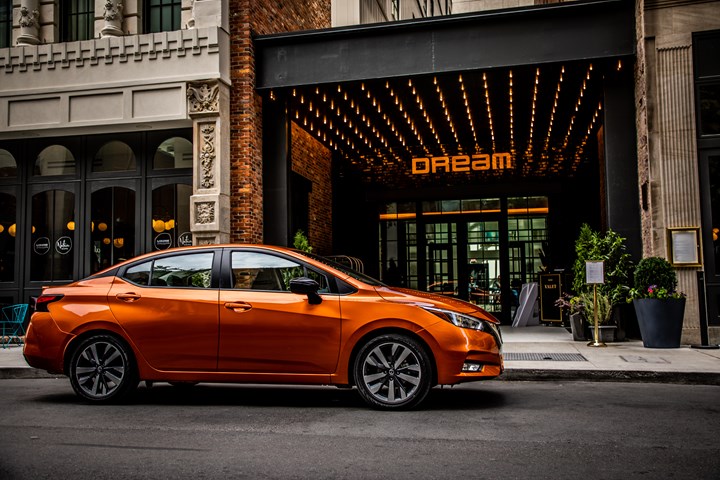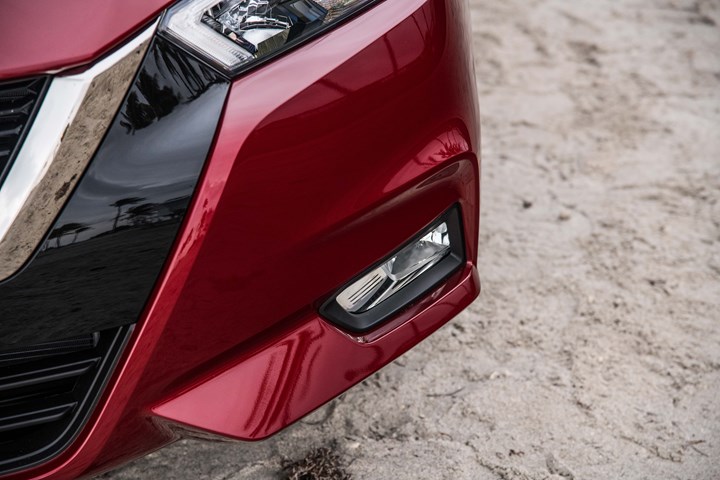All About the 2020 Nissan Versa
Small car with big ideas
#electronics #interior
Why the 2020 Versa Exists

Not a dream, but the real deal: a well-equipped entry-level sedan.
Yes, this is a sedan. An economy compact sedan. Although the sedan segment is declining in popularity such that Nissan’s Rob Warren, director, Chief Marketing Manager, is routinely asked why they have developed a second-generation Versa sedan rather than letting it fade away to the back of dealer lots, he cites some rather compelling data that indicates the 2020 Versa may be helpful to the brand. At its most simple: “Sedans are still a significant portion of the car market.” Warren points out that sedans represent annual sales on the order of three-million units per year in the U.S. market, so that’s a reasonably large slice of the pie that is, of course, dominated by crossovers and pickups, of which Nissan has its assortment of (e.g., Titan, Murano, Rogue, Pathfinder, etc.). What’s more, Warren says they’ve gotten research data from Edelman Intelligence that shows 78% of American drivers who currently don’t own a sedan would consider buying one, and drilling down on that, 85% of the respondents between 18 and 34 would make that consideration. And while the middle term in CUV or SUV is “Utility,” Warren says that 95% of the sedan owners surveyed list “functionality” as the number one thing they like about their cars.
What They Thought in the Studio

The styling of the 2020 Versa brings significantly more edge to what had been a seriously softer exterior.
Kei Yoshitomi, senior manager, Color and Material Design, Nissan Design America, worked on the 2020 Versa both in Japan and in the San Diego studio. Arguably, the approach they took with the car runs somewhat counter to crossover executions, as the plan was to make the vehicle lower. Not higher. But along with lowering the car, they also made it longer and wider, with the purpose of making it sleek. Compared to the outgoing Versa the 2020 is 2.3 inches lower (@ either 57.3 inches or 57.7 inches, depending on trim level), 1.6 inches longer (@ 177 inches) and 1.8 inches wider (@68.5 inches). Yet Yoshitomi says that they still wanted to make sure that the cabin was comfortable for the occupants: the passenger volume is 88.9-ft3. From a styling point of view, they made the exterior have a familial resemblance with the likes of the Maxima and the Altima, so they used the “Emotional Geometry” design language, which means things like the V-Motion grille, boomerang headlights and taillights (the S and SV trim models have standard halogen headlights; the SR has standard LED low and high beams), a kick-up on the C-pillar, and a floating roof. And the execution of the interior was also influenced by the Maxima and Altima, such as with an instrument panel that has a horizontal emphasis, as well as an array of details such as a D-shaped steering wheel, a floating look for the seven-inch center display, and carbon-fiber-like trim accents. And as is becoming almost a requirement, there is visible stitching on the “Zero Gravity” seats.
Serious Stuff

The car features an interior inspired by the Maxima and the Altima and it offers standard tech that one would expect in cars like the Maxima and Altima but not the Versa.
First, let’s get a sense of pricing. There are three trim levels: S, SV and SR. The S has a starting MSRP of $14,730, the SV $17,640 and the SR $18,240. Now realize that there is some sophisticated technology, as in Nissan Safety Shield 360 tech, available as standard on the Versa, including: automatic emergency braking with pedestrian detection, high-beam assist, rear automatic braking, and lane departure warning. All of that standard, even on the entry trim. For those opting for the SV and the SR, blind spot warning and rear cross-traffic alert are added as standard.
Also standard are such things as the aforementioned 7-inch touchscreen, streaming audio via Bluetooth, and cruise control. There are three USB ports. Pushbutton ignition. Once above the S trim there are things like Apple CarPlay and Android Auto and steering wheel controls with voice recognition.
All models are powered by an all-aluminum 1.6-liter, 16-valve DOHC engine that provides 122 hp—12% better than the previous model—and 114 lb-ft of torque—a 7% improvement. (And going back to the earlier point about sedans and crossovers, it is interesting to note that this is the same engine that is used for the Kicks crossover.)
There are two transmissions. A five-speed manual, which is standard on the S trim (which explains, in part, the low starting MSRP), and a D-step Xtronic continuously variable transmission, which is optional on the S and standard on the SV and SR.
A Surprise

Well beyond the basic bacon-and-eggs entry-level vehicle. Nissan thinks the Versa can be a vehicle that will attract young people to the brand—which can pay long-term benefits.
One of the things that is of increasing importance to all automakers is to create cabins that are quite as practical (let’s face it: there’s only so far you can go).
The 2020 Versa comes with standard acoustic laminated windshield glass. This is something that is not ordinarily found on a vehicle that doesn’t have a starting price point of under $15,000.
Sure, it may be a small point. But in some regards, it is a big deal, pointing to the fact that even entry-level vehicles have to have the kinds of features that may have been the purview of higher price points.
RELATED CONTENT
-
2017 Mazda MX-5 Club RF
The Mazda slogan “Driving Matters” pretty much sums up the 2017 MX-5 Miata Club RF.
-
2018 Toyota Land Cruiser
Jules Verne published 20,000 Leagues Under the Sea in 1870; the 1954 film version staring James Mason as Captain Nemo came to mind while driving the Toyota Land Cruiser.
-
Rivian Gets Even More Money, Now From Ford
The electrification of automotive is serious business. This week it was announced that Ford is making a $500-million equity investment in Rivian.


.jpg;width=70;height=70;mode=crop)